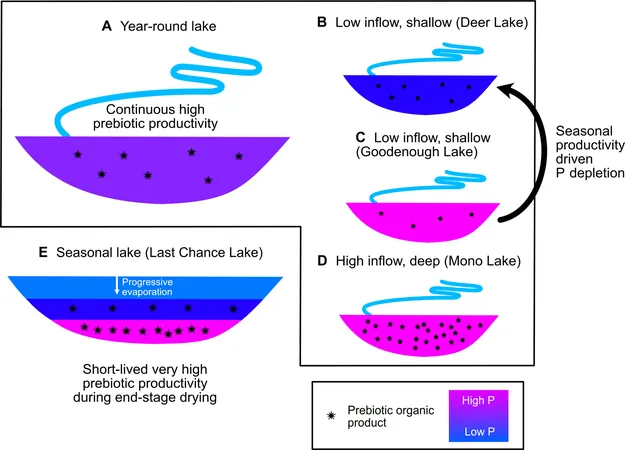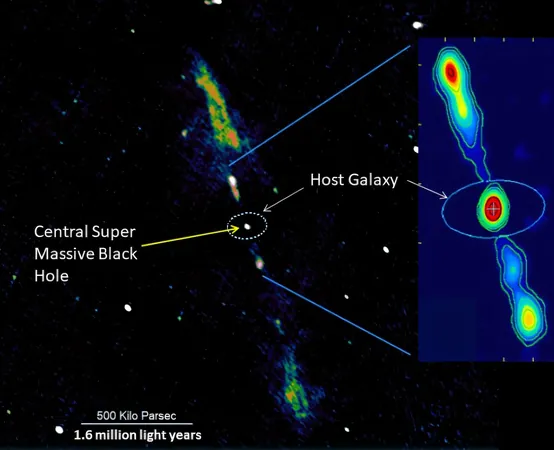
Large Soda Lakes: The Surprising Cradle of Life on Earth?
2025-03-25
Author: Wei Ling
Could large soda lakes be the unsung heroes in the story of life’s origins on Earth? Researchers are now suggesting that these unique environments may have provided the essential conditions necessary for life to begin.
Phosphorus, alongside nitrogen and carbon, is a vital element for all living organisms. It forms the backbone of DNA and RNA, the molecules that carry and store genetic information, as well as ATP (adenosine triphosphate), essential for energy production in cells. While nitrogen and carbon are abundant, phosphorus is relatively scarce at Earth's surface. This rarity has led scientists to ponder how life could have emerged given its high demand and limited availability.
New experiments indicate that prebiotic chemical processes could require phosphorus concentrations as high as 10,000 times more than what is typically found in natural water. This raises an intriguing question: where could such high concentrations of phosphorus have existed on early Earth?
Earth scientist Craig Walton proposes an innovative solution: large soda lakes, which are unique bodies of water that lose their water primarily to evaporation. Unlike rivers and streams that wash away minerals, these lakes retain phosphorus in their waters, allowing for the buildup of high concentrations that could sustain chemical reactions crucial for the emergence of life.
Research has previously suggested that soda lakes could be the birthplace of life, but Walton's work delves deeper into this theory. He is examining the origin of life from a geochemical standpoint at the ETH Zurich's Center for Origin and Prevalence of Life (COPL). Walton emphasizes that not all soda lakes are conducive to fostering life; smaller ones risk depleting their phosphorus supply too quickly to sustain life or the necessary chemical reactions.
In contrast, large soda lakes maintain a consistent influx of phosphorus-rich water while simultaneously losing water through evaporation. This creates a stable environment where phosphorus concentrations can support both chemical reactions and developing life forms without depleting resources. A prime example is Mono Lake in California, which boasts a significantly high and stable phosphorus concentration, allowing a diverse range of organisms to thrive.
Walton’s research suggests that large soda lakes with a constant high phosphorus supply may have provided the perfect incubators for life on early Earth. Unlike smaller bodies of water, which would exhaust their phosphorus quicker than it could be replenished, these expansive lakes were suitable for the long-term development of prebiotic chemistry. This theoretical framework posits that life may have been more likely to arise in vast soda lakes rather than smaller pools, echoing some of Charles Darwin's earlier speculations.
As this research unfolds, it sheds light on a crucial aspect of our planet's story—the conditions that led to the complexity of life we see today. Walton's assertion that large soda lakes were instrumental in the origin of life adds an exciting new dimension to our understanding of how life developed on Earth. This theory not only enriches our knowledge of life's beginnings but also emphasizes the importance of environmental factors in shaping the biological world.
Could these ecosystems still hold secrets about life's evolution? Only time and further research will tell, but one thing is clear: large soda lakes are more than just picturesque bodies of water; they may be the very foundation of life itself!




 Brasil (PT)
Brasil (PT)
 Canada (EN)
Canada (EN)
 Chile (ES)
Chile (ES)
 Česko (CS)
Česko (CS)
 대한민국 (KO)
대한민국 (KO)
 España (ES)
España (ES)
 France (FR)
France (FR)
 Hong Kong (EN)
Hong Kong (EN)
 Italia (IT)
Italia (IT)
 日本 (JA)
日本 (JA)
 Magyarország (HU)
Magyarország (HU)
 Norge (NO)
Norge (NO)
 Polska (PL)
Polska (PL)
 Schweiz (DE)
Schweiz (DE)
 Singapore (EN)
Singapore (EN)
 Sverige (SV)
Sverige (SV)
 Suomi (FI)
Suomi (FI)
 Türkiye (TR)
Türkiye (TR)
 الإمارات العربية المتحدة (AR)
الإمارات العربية المتحدة (AR)